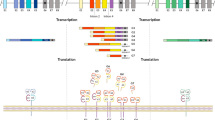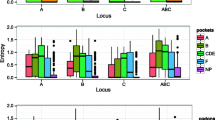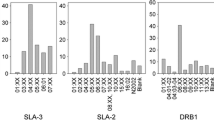Abstract
Wild mice captured in Texas, Scotland, Federal Republic of Germany, Denmark, Spain, Greece, Israel, Egypt, and Chile were mated to inbred strains and through successive backcross matings and H-2 typing lines homozygous for wild-derivedH-2, haplotypes were established. The lines, which are neither congenic nor inbred, were then typed with antibodies defining knownH-2 alleles at class I and class II loci. In addition, antisera were produced by the immunization of inbred strains with tissues of the new lines. Sixteen of the lines were characterized in this manner. The characterization resulted in the identification of 16 newH-2 haplotypes, 11 new K alleles., 10 newD alleles, and 21 new class I antigenic determinants, most of them of the private type. Most of the haplotypes represent natural recombinants sharing segments of theH-2 complex with previously identified haplotypes. A number of haplotypes are recombinants between the K and the A loci, which in genetic studies have proved difficult to separate. The lines, however, also provide evidence for preservation of blocks of genes in theH-2 complex, particularly in the class II region. Some of class I alleles previously found in wild mice from Michigan have now been found again in these mice. Several class II alleles of these lines appear to be the same as those found in inbred strains. Identical or nearly identical class I and class II alleles thus commonly occur in different populations. These findings strengthen the argument that in populations,H-2 alleles are relatively stable.
Similar content being viewed by others
References
Arden, B. and Klein, J.: Biochemical comparison of major histocompatibility complex molecules from different subspecies ofMus musculus: evidence fortrans-specific evolution of alleles.Proc. Natl. Acad. Sci. U.S.A. 79: 2342–2346, 1982
Arden, B., Wakeland, E. K., and Klein, J.: Structural comparisons of serologically indistinguishable H2K-encoded antigens from inbred and wild mice.J. Immunol. 125: 2424–2428, 1980
Arden, B., Wakeland, E. K., and Klein, J.: Minor structural variant ofH-2K-controlled molecules in wild mice.Immunogenetics 16: 491–493, 1982
Bregegere, F.: A model for the role of gene conversion in H-2 polymorphism.Biochimie, in press, 1983
Bruning, J. W., Claas, F. H. J., Kardol, M. J., Lansbergen, Q., Naipal, A. M., and Tanke, H. J.: Automated reading of HLA-A, B, C typing and screening. The Propidium Iodide (PI) method.Human Immunol. 5: 225–231, 1982
Duncan, W. R. and Klein, J.: Histocompatibility-2 system in wild mice. IX. Serological analysis of 13 new B10.W congenic lines.Immunogenetics 14: 45–65, 1980
Figueroa, F., Klein, D., Tewarson, S., and Klein, J.: Evidence for placing theNeu-1 locus within the mouseH-2 complex.J. Immunol. 129: 2089–2093, 1982a
Figueroa, F., Tewarson, S., Neufeld, E., and Klein, J.:H-2 Haplotypes of strains DBR7, B 10.NZW, NFS, BQ2, STU, TO1 and TO2.Immunogenetics 15: 431–436, 1982b
Figueroa, F., Zaleska-Rutczynska, Z., Adolph, S., Nadeau, J. H., and Klein, J.: Genetic variation of wild mouse populations in Southern Germany. II. Serological Study.Genet. Res. (Camb.) 43: 135–144, 1982
Götze, D., Nadeau, J., Wakeland, E. K., Berry, R. J., Bonhomme, F., Egorov, I. K., Hjorth, J. P., Hoogstraal, H., Vives, J., Winking, H., and Klein, J.: Histocompatibility-2 system in wild mice. X. Frequencies of H-2 and Ia antigens in wild mice from Europe and Africa.J. Immunol. 124: 2675–2681, 1980
Klein, J.: Histocompatibility-2 system in wild mice. I. Identification of five newH-2 chromosomes.Transplantation 13: 291–299, 1972
Klein, J.: Evolution and function of the major histocompatibility complex.In Parham and J. Strominger (eds.)Histocompatibility Antigens: Structure and function (Receptors and Recognition, Series B), vol. 14, 223–239, 1982
Klein, J. and Figueroa, F.: Polymorphism of the mouseH-2 loci.Immunol. Rev. 60: 23–57, 1981
Klein, J., Figueroa, F., and David, C. S.:H-2 Haplotypes, genes and antigens: second listing. II. TheH-2 complex.Immunogenetics 17: 553–596, 1983
Klein, J., Hauptfeld, V., and Hauptfeld, M.: Evidence for a fifth (G) region in theH-2 complex of the mouse.Immunogenetics 2: 141–150, 1975
Klein, J., Klein, D., and Shreffler, D. C.: H-2 types of translocation stocks T (2; 9) 138Ca, T (9; 13) 190Ca and anH-2 recombinant.Transplantation 10: 309–320, 1970
Köhler, G. and Milstein, C.: Continuous cultures of fused cells secreting antibody of predefined specificity.Nature 256: 495–497, 1975
Nathenson, S. G., Uehara, H., Ewenstein, B. M., Kindt, T. J., and Coligan, J. E.: Primary structural analysis of transplantation antigens of the murine H-2 major histocompatibility complex.Ann. Rev. Biochem. 50: 1025–1052, 1981
Passmore, H. C. and Shreffler, D. C.: A sex-limited serum protein variant in the mouse; inheritance and association with theH-2 region.Biochem. Genet. 4: 351–365, 1970
Sachs, D. H., Arn, J. S., and Hansen, T. H.: Two new recombinantH-2 haplotypes, one of which juxtaposesK b andI k alleles.J. Immunol. 123: 1965–1969, 1979
Shiroishi, T., Sagai, T., and Moriwaki, K.: A new wild-derivedH-2 haplotype enhancingK-IA recombination.Nature 300: 370–372, 1982
Shreffler, D. C. and David, C. S.: Studies on recombination within the mouseH-2 complex. I. Three recombinants which position theSs locus within the complex.Tissue Antigens 2: 232–240, 1972
Shreffler, D. C. and Owen, R. D.: A serologically detected variant in mouse serum: Inheritance and association with the histocompatibility-2 locus.Genetics 48: 9–25, 1963
Stimpfling, J. H.: The use of PVP as a developing agent in mouse hemagglutination tests.Transplant. Bull. 9: 109–111, 1961
Zaleska-Rutczynska, Z. and Klein, J.: Histocompatibility-2 system in wild mice. V. Serological analysis of sixteen B10.W congenic lines.J. Immunol. 119: 1903–1911, 1977
Author information
Authors and Affiliations
Rights and permissions
About this article
Cite this article
Zaleska-Rutczynska, Z., Figueroa, F. & Klein, J. Sixteen newH-2 haplotypes derived from wild mice. Immunogenetics 18, 189–203 (1983). https://doi.org/10.1007/BF00952959
Received:
Revised:
Issue Date:
DOI: https://doi.org/10.1007/BF00952959




